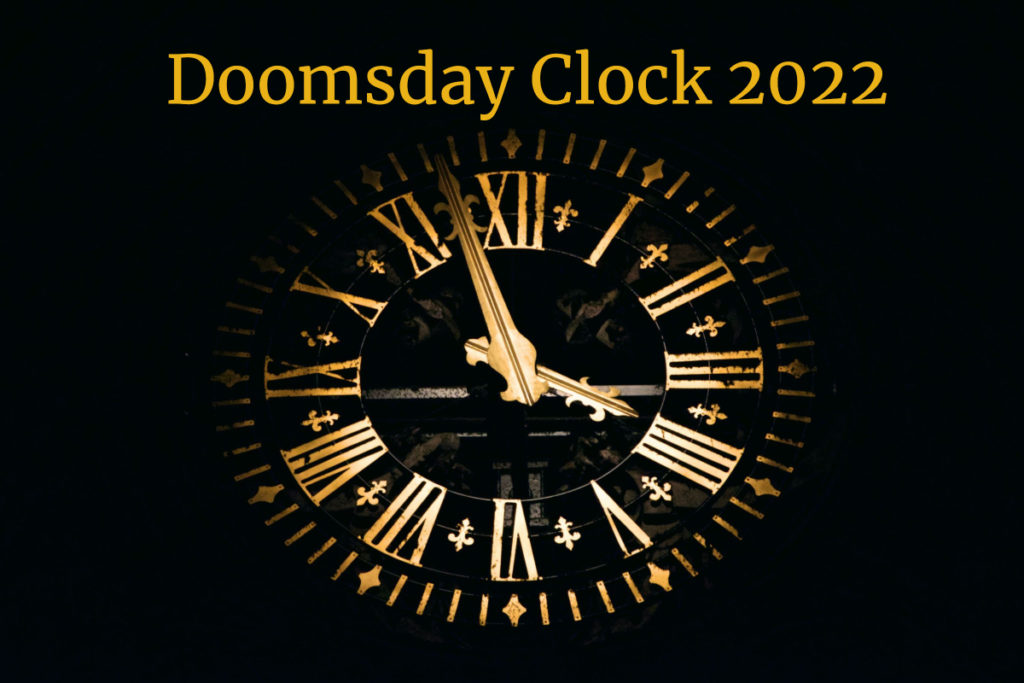The Bulletin of Atomic Scientists just released a new update about the Doomsday Clock. This update was directly influenced by the Russian invasion of Ukraine. Read on to learn more about where the Doomsday Clock is now in 2022, and what the Bulletin said.
The clock is one method of trying to determine just how close we are to the end of the world. The Bulletin of Atomic Scientists moves the clock forward or backward depending on what’s going on in the world at the time.
‘This Is What 100 Seconds to Midnight Looks Like’
The Bulletin of Atomic Scientists shared in a press statement on March 7, 2022, that they were keeping the Doomsday Clock at 100 seconds to midnight — a position they chose in late January 2022. Every year, the Doomsday Clock is updated in late January based on world events. The Bulletin of Atomic Scientists released the breaking update based on the current world situation, in which nuclear weapons have been directly referenced in recent weeks.
The Bulletin of Atomic Scientists noted that when they chose to put the clock at 100 seconds to midnight in January, it was partially because of the situation in Ukraine. As of now, the time on the clock hasn’t changed from January. But they’ve taken this opportunity to explain to people why they chose the 100 seconds time and why it’s staying.
They wrote: “In the wake of Russia’s invasion of Ukraine and the Russian takeover of the Zaporizhzhia nuclear power plant, the Bulletin of the Atomic Scientists’ Science and Security Board announced that the Clock will stay at 100 seconds to midnight—the closest humanity has ever been to self-destruction. The board is a select group of globally-recognized leaders who set the Doomsday Clock, and it recently convened to discuss the latest developments in Ukraine.”
They continued, writing:
In January 2022 the Science and Security Board of the Bulletin of the Atomic Scientists set the Doomsday Clock at 100 seconds to midnight. At that time, we called out Ukraine as a potential flashpoint in an increasingly tense international security landscape. For many years, we and others have warned that the most likely way nuclear weapons might be used is through an unwanted or unintended escalation from a conventional conflict. Russia’s invasion of Ukraine has brought this nightmare scenario to life, with Russian President Vladimir Putin threatening to elevate nuclear alert levels and even first use of nuclear weapons if NATO steps in to help Ukraine. This is what 100 seconds to midnight looks like.
The Board Warned of Global Catastrophe
The Science and Security Board noted that they were condemning Russia’s invasion of Ukraine.
They wrote, “We call on all countries to denounce Russia’s actions and Putin’s outrageous threats of nuclear use, and for Russia to withdraw its forces and live up to its 1994 pledge—made as part of the successful process of ensuring Ukraine did not gain control over the 1,900 nuclear weapons left on its territory when the Soviet Union dissolved—to fully respect Ukraine’s territorial integrity. Anything less is an affront to the rule of law and the principle of national self-determination. Anything less risks global catastrophe.”
How does the Doomsday Clock work?
In an FAQ, they explain: “The Doomsday Clock is a design that warns the public about how close we are to destroying our world with dangerous technologies of our own making. It is a metaphor, a reminder of the perils we must address if we are to survive on the planet. When the Doomsday Clock was created in 1947, the greatest danger to humanity came from nuclear weapons, in particular from the prospect that the United States and the Soviet Union were headed for a nuclear arms race.”
In 1991, they moved the clock to 17 minutes to midnight based on the Strategic Arms Reduction Treaty signed by the Soviet Union and the United States.
In 2018, the clock was moved from two-and-half minutes to midnight to two minutes. This was the closest the clock had ever been to midnight since 1953, when it was moved to two minutes after the U.S. and Soviet Union each tested their first thermonuclear weapons.
In 2020, the clock moved to 100 seconds to midnight, which was the closest it had been to midnight in history. It remains there today.
Their website notes that it didn’t move during the Cuban Missile Crisis in 1962 because there was too-little known at the time about what was happening.
You can see the clock’s full timeline here.
Want to chat about all things post-apocalyptic? Join our Discord server here. You can also follow us by email here, on Facebook, or Twitter. Oh, and TikTok, too!

